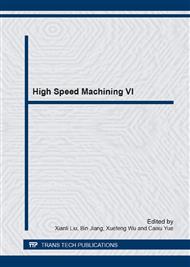[1]
T. D. Swanson, G. C. Binlr. NASA thermal contml technologies for robotic spacecraft. Applied Thermal Engineering. 2003, 23(9): 1055-1065.
DOI: 10.1016/s1359-4311(03)00036-x
Google Scholar
[2]
J. Koo, C. K1einstreuer. Analysis of surface roughness effects on heat transfer in micro-conduits. Intemational Joumal of Heat Mass Transfer. 2005. 48: 2625-2634.
DOI: 10.1016/j.ijheatmasstransfer.2005.01.024
Google Scholar
[3]
H. Wu, P. Cheng. Friction factors in smooth trapezoidal silicon microchannels with difrerent aspect ratios, International Joumal of Heat Mass Transfer. 2003. 46: 25 l 9-2525.
DOI: 10.1016/s0017-9310(03)00106-6
Google Scholar
[4]
M. Hashish. Cutting with abrasive waterjets. Mechanical Engineering. 3 (1984) 60-69.
Google Scholar
[5]
J. Wang, D. M. Guo. A Predictive Depth of Penetration Model for Abrasive Waterjet Cutting of Polymer Matrix Composites. Journal of Materials Processing Technology. 121 (2002) 390-394.
DOI: 10.1016/s0924-0136(01)01246-8
Google Scholar
[6]
H. Hocheng, K.R. Chang. Material removal analysis in abrasive waterjet cutting of ceramics plates. Journal of Materials Processing Technology. 40 (1994) 287-304.
DOI: 10.1016/0924-0136(94)90456-1
Google Scholar
[7]
Jiyue Zeng, Thomas J. Kim. An erosion model for abrasive waterjet milling of polycrystalline ceramics. Wear. 199 (1996) 275-282.
DOI: 10.1016/0043-1648(96)07223-7
Google Scholar
[8]
M. Hashish. Turning with abrasive-waterjets-a first investigation[J]. Journal of Engineering for Industry. 109 (1987) 281-290.
DOI: 10.1115/1.3187130
Google Scholar
[9]
Z.H. Guo. Experimental and numerical analysis of abrasive waterjet drilling of brittle materials[D]. A Dissertation Submitted for The Degree of Doctor of Philosophy of University of Washington. (1998) 50-89.
Google Scholar
[10]
R. Balasubramaniam, J. Krishnan, N. Ramakrishnam. A study on the shape of the surface generated by abrasive jet machining. Journal of Materials Processing Technology, 121(2002) 102-106.
DOI: 10.1016/s0924-0136(01)01209-2
Google Scholar
[11]
F.L. Chen, E. Siores, W.C.K. Wong. Kerf characteristics in abrasive waterjet cutting of ceramic materialsInternational[J]. Journal of Machine Tools and Manufacture. 36 (1996) 1201-1206.
DOI: 10.1016/0890-6955(95)00108-5
Google Scholar
[12]
E. Savrun, M. Taya. Surface characterization of SiC whisker/2124 aluminium and Al2O3 composites machined by abrasive water jet[J]. Journal of Materials Science. (1988) 1453-1458.
DOI: 10.1007/bf01154616
Google Scholar
[13]
H. Hocheng, K.R. Chang. Material removal analysis in abrasive waterjet cutting of ceramics plates [J]. Journal of Materials Processing Technology. 40(1994) 287-304.
DOI: 10.1016/0924-0136(94)90456-1
Google Scholar


